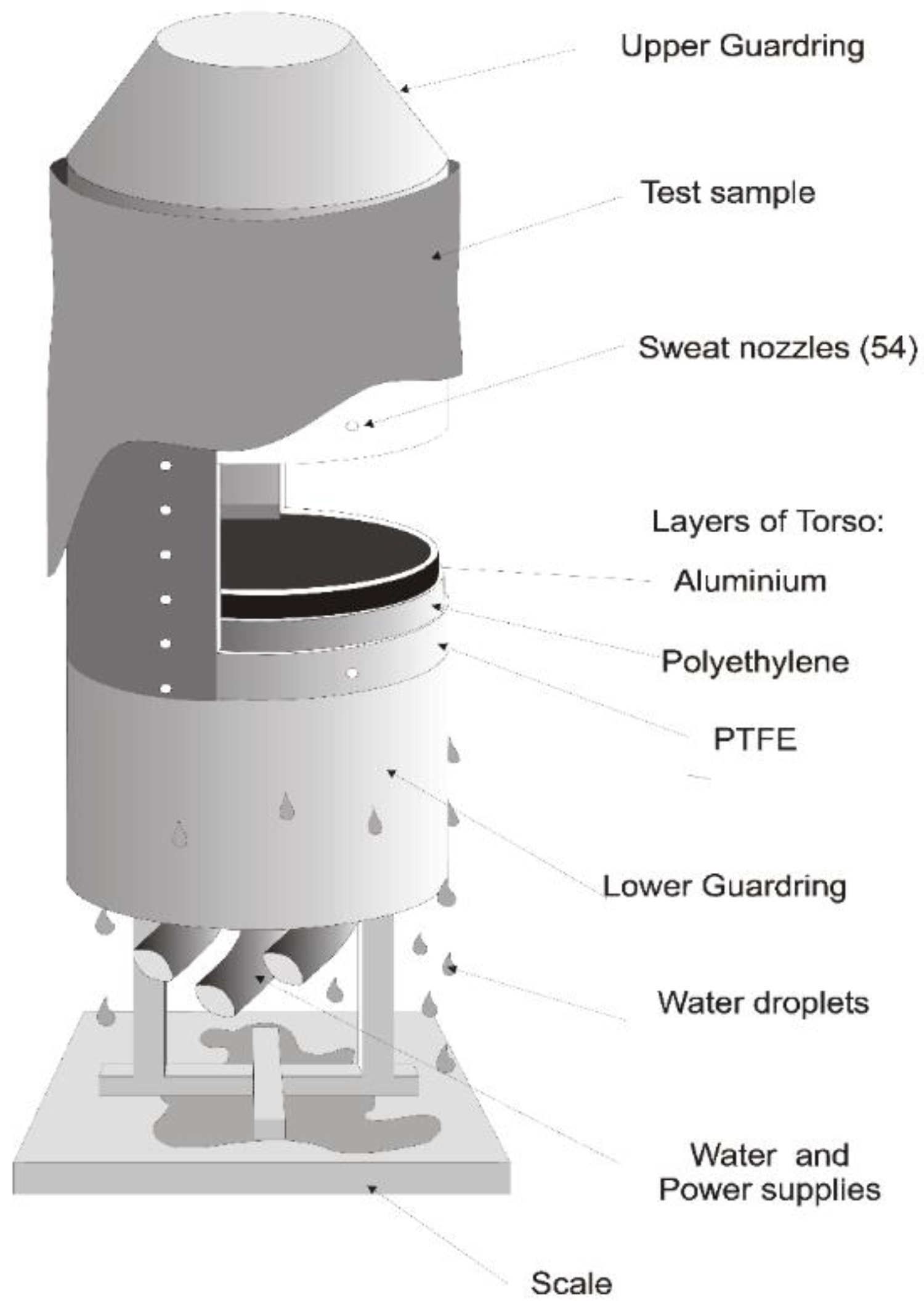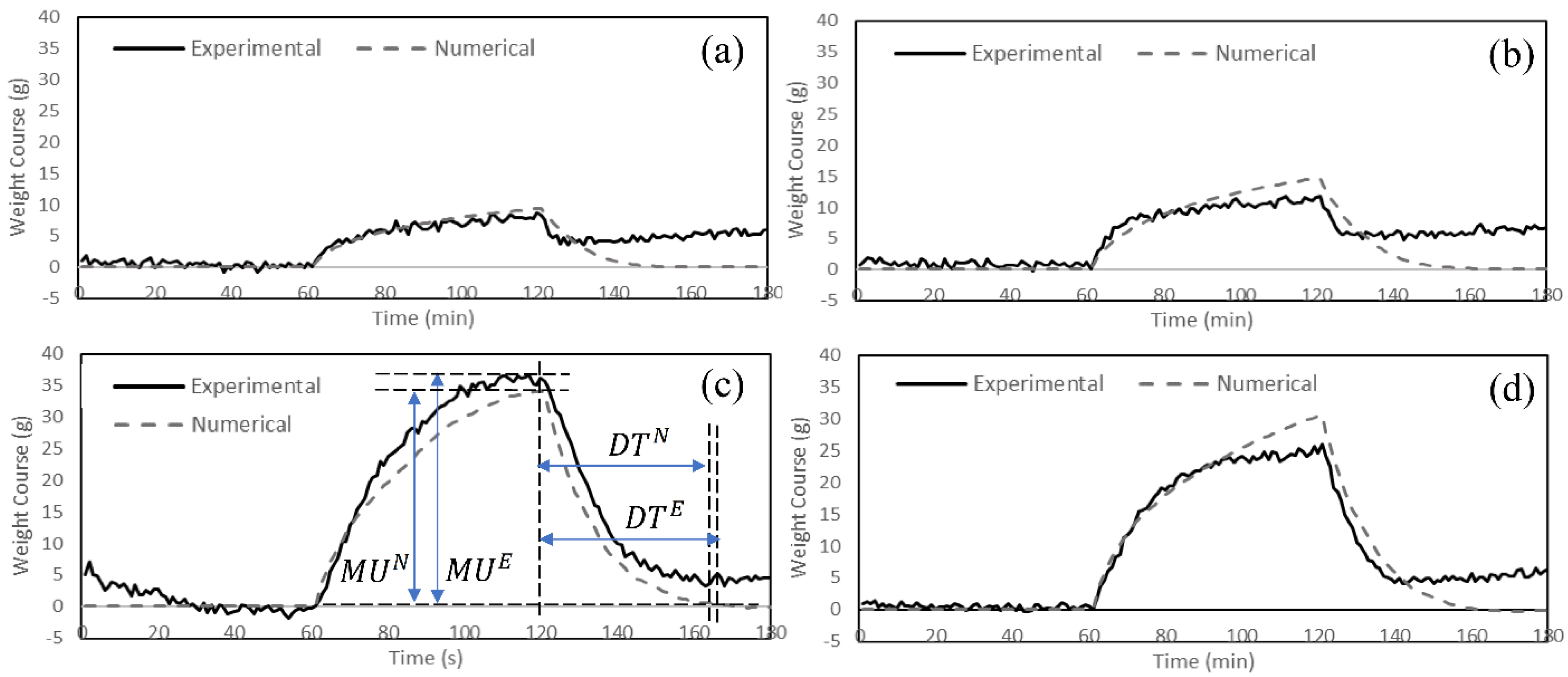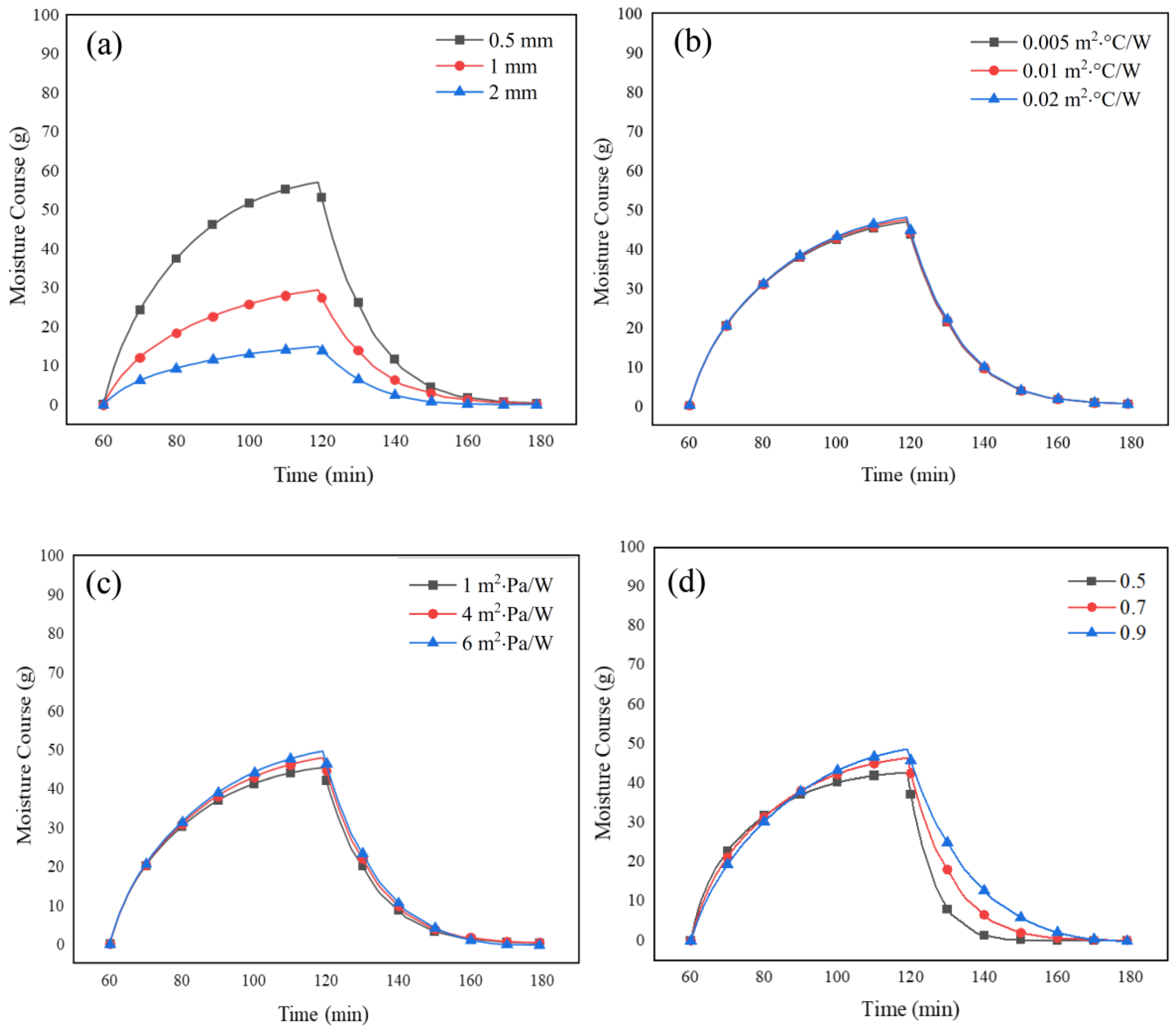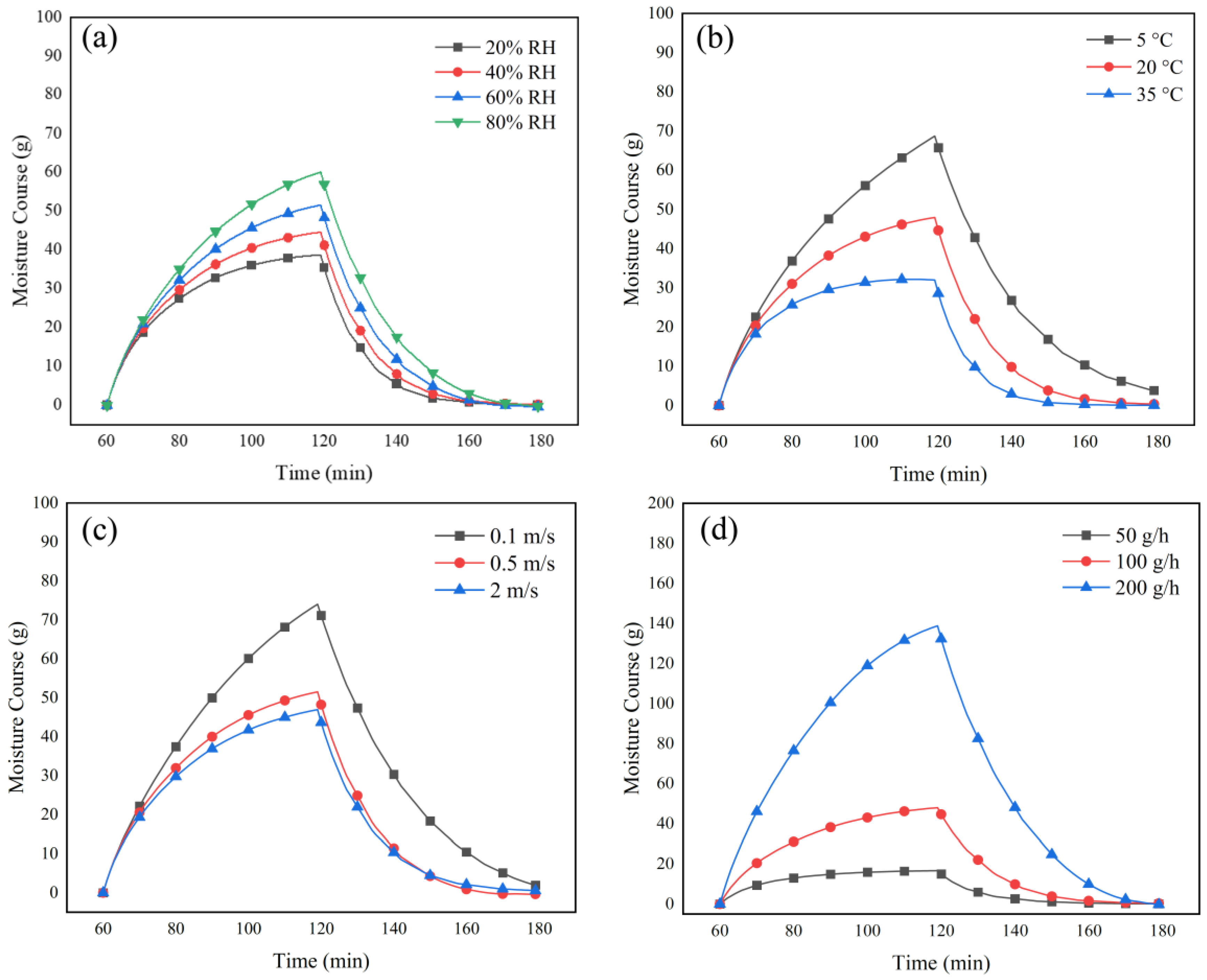Modeling and Prediction of Thermophysiological Comfort Properties of a Single Layer Fabric System Using Single Sector Sweating Torso
Abstract
1. Introduction
Research Gap and Objective of the Present Work
2. Material and Methods
2.1. Fabrics
2.2. Fabric Physical Property Measurement
2.3. Measurement with the Single Sector Sweating Torso
3. Numerical Modeling
3.1. Geometric Model
3.2. Material Properties
3.3. Physics Setup
3.4. Study Setup
4. Results and Discussion
4.1. General Observations
4.2. Model Predictability
4.3. Parametric Study
4.3.1. Effect of Fabric System Properties
4.3.2. Effect of Environmental Conditions and Sweat Rate
5. Conclusions
Author Contributions
Funding
Institutional Review Board Statement
Informed Consent Statement
Data Availability Statement
Acknowledgments
Conflicts of Interest
References
- Ho, C.P.; Fan, J.; Newton, E.; Au, R. 7—Improving thermal comfort in apparel. In Improving Comfort in Clothing; Song, G., Ed.; Woodhead Publishing: Cambridge, UK, 2011; p. 165. [Google Scholar]
- Horn, M.J. The Second Skin: An Interdisciplinary Study of Clothing, 3rd ed.; Houghton Mifflin: Boston, MA, USA, 1981; p. xii. [Google Scholar]
- Song, G. Thermal insulation properties of textiles and clothing. In Textile for Cold Weather Apparel; Williams, J., Ed.; Woodhead Publishing Ltd.: Cambridge, UK, 2009; p. 261. [Google Scholar]
- Li, Y. The Science of Clothing Comfort Text. Text. Prog. 2001, 31, 1. [Google Scholar] [CrossRef]
- Classen, E. 3—Comfort testing of textiles. In Advanced Characterization and Testing of Textiles; Dolez, P., Vermeersch, O., Izquierdo, V., Eds.; Woodhead Publishing: Cambridge, UK, 2018; p. 59. [Google Scholar]
- Troynikov, O.; Watson, C. 5—Knitting technology for seamless sportswear. In Textiles for Sportswear; Shishoo, R., Ed.; Woodhead Publishing: Cambridge, UK, 2015; p. 95. [Google Scholar]
- Li, Y.I.; Wong, A.S.W. 4—Physiology of thermal comfort. In Clothing Biosensory Engineering; Li, Y., Wong, A.S.W., Eds.; Woodhead Publishing: Cambridge, UK, 2006; p. 60. [Google Scholar]
- McCullough, E.A.; Kwon, M.; Shim, H. A comparison of standard methods for measuring water vapour permeability of fabrics. Meas. Sci. Technol. 2003, 14, 1402. [Google Scholar] [CrossRef]
- Kar, F.; Fan, J.; Yu, W. Comparison of different test methods for the measurement of fabric or garment moisture transfer properties. Meas. Sci. Technol. 2007, 18, 2033. [Google Scholar] [CrossRef]
- Zimmerli, T.; Weder, M.S. Protection and comfort—A sweating torso for the simultaneous measurement of protective and comfort properties of PPE. In Performance of Protective Clothing, 6th Volume; Stull, J.O., Schwope, A.D., Eds.; American Society Testing and Materials: West Conshohocken, PA, USA, 1997; Volume 1273, p. 271. [Google Scholar]
- Fan, J.T.; Chen, Y.S. Measurement of clothing thermal insulation and moisture vapour resistance using a novel perspiring fabric thermal manikin. Meas. Sci. Technol. 2002, 13, 1115. [Google Scholar] [CrossRef]
- Mandal, S.; Annaheim, S.; Camenzind, M.; Rossi, R.M. 5—Evaluation of thermo-physiological comfort of clothing using manikins. In Manikins for Textile Evaluation; Nayak, R., Padhye, R., Eds.; Woodhead Publishing: Cambridge, UK, 2017; p. 115. [Google Scholar]
- Psikuta, A.; Richards, M.; Fiala, D. Single-sector thermophysiological human simulator. Physiol. Meas. 2008, 29, 181. [Google Scholar] [CrossRef]
- Psikuta, A.; Wang, L.-C.; Rossi, R.M. Prediction of the physiological response of humans wearing protective clothing using a thermophysiological human simulator. J. Occup. Environ. Hyg. 2013, 10, 222. [Google Scholar] [CrossRef]
- Bogerd, N.; Psikuta, A.; Daanen HA, M.; Rossi, R.M. How to measure thermal effects of personal cooling systems: Human, thermal manikin and human simulator study. Physiol. Meas. 2021, 31, 1161. [Google Scholar] [CrossRef][Green Version]
- ISO. ISO 18640-1: Protective Clothing for Firefighters—Physiological Impact—Part 1: Measurement of Coupled Heat and Moisture Transfer with the Sweating Torso; International Organization for Standardization: Geneva, Switzerland, 2018. [Google Scholar]
- Joshi, A.; Wang, F.; Kang, Z.; Yang, B.; Zhao, D. A three-dimensional thermoregulatory model for predicting human thermophysiological responses in various thermal environments. Build. Environ. 2022, 207, 108506. [Google Scholar] [CrossRef]
- Henry, P.S.H. The diffusion of moisture and heat through textiles. Discuss. Faraday Soc. 1948, 3, 243. [Google Scholar] [CrossRef]
- Farnworth, B. Mechanisms of heat flow through clothing insulation. Text. Res. J. 1983, 53, 717. [Google Scholar] [CrossRef]
- Torvi, D. Heat Transfer in Thin Fibrous Materials under High Heat Flux Conditions; University of Alberta: Edmonton, AB, Canada, 1997. [Google Scholar]
- Fan, J.T.; Du, N.; Wu, H.; Sun, W. Heat and Mass Transport through Porous Fibrous Insulation: Modeling and Optimization. In Iscm Ii and Epmesc Xii, Pts 1 and 2; Lu, J.W.Z., Leung, A.Y.T., Iu, V.P., Mok, K.M., Eds.; Amer Inst Physics: Melville, NY, USA, 2010; Volume 1233, p. 1184. [Google Scholar]
- Fan, J.T.; Wen, X.H. Modeling heat and moisture transfer through fibrous insulation with phase change and mobile condensates. Int. J. Heat Mass Transf. 2002, 45, 4045. [Google Scholar] [CrossRef]
- Min, K.; Son, Y.; Kim, C.; Lee, Y.; Hong, K. Heat and moisture transfer from skin to environment through fabrics: A mathematical model. Int. J. Heat Mass Transf. 2007, 50, 5292. [Google Scholar] [CrossRef]
- Li, Y.; Holcombe, B.V. Mathematical simulation of heat and moisture transfer in a human-clothing-environment system. Text. Res. J. 1998, 68, 389. [Google Scholar] [CrossRef]
- Ding, D.; Tang, T.; Song, G.; McDonald, A. Characterizing the performance of a single-layer fabric system through a heat and mass transfer model-Part I: Heat and mass transfer model. Text. Res. J. 2011, 81, 398. [Google Scholar] [CrossRef]
- Ding, D.; Tang, T.; Song, G.; McDonald, A. Characterizing the performance of a single-layer fabric system through a heat and mass transfer model-Part II: Thermal and evaporative resistances. Text. Res. J. 2011, 81, 945. [Google Scholar] [CrossRef]
- Kang, Z.; Shou, D.; Fan, J. Numerical modeling of body heat dissipation through static and dynamic clothing air gaps. Int. J. Heat Mass Transf. 2020, 157, 119833. [Google Scholar] [CrossRef]
- Joshi, A.; Psikuta, A.; Bueno, M.-A.; Annaheim, S.; Rossi, R.M. Analytical clothing model for sensible heat transfer considering spatial heterogeneity. Int. J. Therm. Sci. 2019, 145, 105949. [Google Scholar] [CrossRef]
- Mert, E.; Psikuta, A.; Bueno, M.-A.; Rossi, R.M. Effect of heterogenous and homogenous air gaps on dry heat loss through the garment. Int. J. Biometeorol. 2015, 59, 1701. [Google Scholar] [CrossRef]
- Deng, M.; Psikuta, A.; Wang, Y.; Annaheim, S.; Rossi, R.M. Numerical investigation of the effects of heterogeneous air gaps during high heat exposure for application in firefighter clothing. Int. J. Heat Mass Transf. 2021, 181, 121813. [Google Scholar] [CrossRef]
- Kyosov, M.; Angelova, R.A.; Stankov, P. Numerical modeling of the air permeability of two-layer woven structure ensembles. Text. Res. J. 2016, 86, 2067. [Google Scholar] [CrossRef]
- Gadeikytė, A.; Abraitiene, A.; Barauskas, R. Prediction of air permeability coefficient and water-vapor resistance of 3D textile layer. J. Text. Ins. 2021, 113, 396. [Google Scholar] [CrossRef]
- Pezzin, A. Thermo-Physiological Comfort Modelling of Fabrics and Garments; Politecnico di Torino: Turin, Italy, 2015. [Google Scholar]
- COMSOL Multiphysics 6.0. Introduction to COMSOL Multiphysics. 2021. Available online: https://cdn.comsol.com/doc/6.0.0.405/IntroductionToCOMSOLMultiphysics.pdf (accessed on 31 July 2022).
- Codău, T.C.; Codău, E.; Cioară, I. Simulation of Water Vapours Diffusion through Textile Structures. In The New Technologies and Redesigning Learning Spaces; Carol I National Defense University Publishing House: Bucharest, Romania, 2019; Volume III, p. 377. [Google Scholar]
- Parsons, K.C. Human Thermal Environments: The Effects of Hot, Moderate, and Cold Environments on Human Health, Comfort, and Performance, 3rd ed.; CRC Press: Boca Raton, FL, USA; Taylor & Francis Group: Boca Raton, FL, USA, 2014. [Google Scholar]
- Kulichenko, A.V. Theoretical analysis, calculation, and prediction of the air permeability of textiles. Fibre Chem. 2005, 37, 371. [Google Scholar] [CrossRef]
- Keiser, C.; Becker, C.; Rossi, R.M. Moisture transport and absorption in multilayer protective clothing fabrics. Text. Res. J. 2008, 78, 604. [Google Scholar] [CrossRef]
- Das, A.; Alagirusamy, R. Science in Clothing Comfort; Woodhead Publishing: Delhi, India, 2010. [Google Scholar]
- Rossi, R. 10—Interactions between protection and thermal comfort A2—Scott, Richard A. In Textiles for Protection; Woodhead Publishing: Cambridge, UK, 2005; p. 233. [Google Scholar]
- ASTM D3776/D3776M-20; Standard Test Methods for Mass Per Unit Area (Weight) of Fabric. ASTM International: West Conshohocken, PA, USA, 2020.
- ASTM D1777-96; Standard Test Method for Thickness of Textile Materials. American Society for Testing and Materials: West Conshohocken, PA, USA, 2019.
- ASTM D737-18; Standard Test Method for Air Permeability of Textile FABrics. American Society for Testing and Materials: West Conshohocken, PA, USA, 2018.
- ISO. ISO 11092: Textile--Phsiological Effect—Measurment of Thermal and Water-Vapour Resistance under Steady-State Conditions (Sweating Guarded-Hotplate Test); Standard Organization for Standardization: Geneva, Switzerland, 2014. [Google Scholar]
- Gajjar, C.; King, M.; Guidoin, R. (Eds.) 8—Retrieval studies for medical biotextiles. In Biotextiles as Medical Implants; Woodhead Publishing: Cambridge, UK, 2013; p. 182. [Google Scholar]
- Hearle, J.W.; Grosberg, P.; Backer, S. Structural Mechanics of Fibers, Yarns, and Fabrics; Wiley-Interscience: New York, NY, USA, 1969. [Google Scholar]
- Taheri, M.; Vadood, M.; Johari, M.S. Investigating the effect of yarn count and twist factor on the packing density and wicking height of lyocell ring-spun yarns. Fibers Polym. 2013, 14, 1548. [Google Scholar] [CrossRef]
- Morton, W.E.; Hearle, J.W.S. 5—Fibre density. In Physical Properties of Textile Fibres, 4th ed.; Morton, W.E., Hearle, J.W.S., Eds.; Woodhead Publishing: Cambridge, UK, 2008; p. 163. [Google Scholar]
- Gholamreza, F. Performance of Thermal Protective Clothing Upon Exposure to Hot Liquid Splash; University of Alberta: Edmonton, AB, Canada, 2018. [Google Scholar]
- ISO. ISO 6330: Domestic Washing and Drying Procedures for Textile Testing; International Organization for Standardization: Geneva, Switzerland, 2021. [Google Scholar]
- Codau, T.-C.; Onofrei, E.; Petrusic, S.; Bedek, G.; Dupont, D.; Soulat, D. Mathematical correlation of test methods for measuring water-vapor transmission through fabrics. J. Porous Media 2015, 18, 245. [Google Scholar] [CrossRef]
- COMSOL Multiphysics 6.0. Chemical Reaction Engineering Module User’s Guide. 2021. Available online: https://doc.comsol.com/6.0/doc/com.comsol.help.chem/ChemicalReactionEngineeringModuleUsersGuide.pdf (accessed on 31 July 2022).
- Monteith, J.L.; Unsworth, M.H. Principles of Environmental Physics: Plants, Animals, and the Atmosphere, 4th ed.; Elsevier/Academic Press: Amsterdam, The Netherlands; Boston, MA, USA, 2013. [Google Scholar]
- Datta, A.K. Porous media approaches to studying simultaneous heat and mass transfer in food processes. I: Problem formulations. J. Food Eng. 2007, 80, 80. [Google Scholar] [CrossRef]
- Morton, W.E.; Hearle, J.W.S. 7—Equilibrium absorption of water. In Physical Properties of Textile Fibres, 4th ed.; Morton, W.E., Hearle, J.W.S., Eds.; Woodhead Publishing: Cambridge, UK, 2008; p. 178. [Google Scholar]
- Gholamreza, F.; Nadaraja, A.V.; Milani, A.S.; Golovin, K. Enhanced protection face masks do not adversely impact thermophysiological comfort. PLoS ONE 2022, 17, e0265126. [Google Scholar] [CrossRef]
- Morton, W.E.; Hearle, J.W.S. 9—Rate of absorption of moisture. In Physical Properties of Textile Fibres, 4th ed.; Morton, W.E., Hearle, J.W.S., Eds.; Woodhead Publishing: Cambridge, UK, 2008; p. 202. [Google Scholar]
- Bin, Y.; Huapeng, Z.; Ying, Z.; Xiaodan, P.; Guoliang, H. Lecturing and Reflections on the Fiber Heats of Sorption Part I. In Frontiers in Computer Education; Sambath, S., Zhu, E., Eds.; Springer: Berlin/Heidelberg, Germany, 2012; p. 75. [Google Scholar]
- Corberan, J.M.; Verde, M.; Gil, M.; Martinez, N. Study of adsorption materials for their application as perspiration-absorbing textiles. Text. Res. J. 2010, 80, 1160. [Google Scholar] [CrossRef]
- Morton, W.E.; Hearle, J.W.S. 8—Heats of sorption. In Physical Properties of Textile Fibres, 4th ed.; Morton, W.E., Hearle, J.W.S., Eds.; Woodhead Publishing: Cambridge, UK, 2008; p. 195. [Google Scholar]
- Morton, W.E.; Hearle, J.W.S. 10—The retention of liquid water. In Physical Properties of Textile Fibres, 4th ed.; Morton, W.E., Hearle, J.W.S., Eds.; Woodhead Publishing: Cambridge, UK, 2008; p. 229. [Google Scholar]
- Smith, C.J.; Havenith, G. Body mapping of sweating patterns in male athletes in mild exercise-induced hyperthermia. Eur. J. Appl. Physiol. 2011, 111, 1391. [Google Scholar] [CrossRef]







| Fabrics | Fiber Content | Fabric Structure | Surface Property |
|---|---|---|---|
| Fabric A | 86% Polyester, 14% Elastane | Plain weave (woven) | Wicking finish |
| Fabric B | 51% Nylon, 38% Polyester, 8% Elastane, 3% X-static | Single jersey (knit) | Wicking finish |
| Fabric C | 71% Pima cotton, 24% Lyocell, 5% Elastane | Single jersey (knit) | Water repellent finish |
| Fabric D | 83% Nylon, 17% Elastane | Single jersey (knit) | Wicking finish |
| Fabrics | Mass (g/m2) | Thickness (mm) | Fabric Density (Kg/cm3) | Air Permeability (cm3/cm2/s) | Porosity | Rct (m2·K/W) | Ret (m2·Pa/W) |
|---|---|---|---|---|---|---|---|
| Fabric A | 127 | 0.30 ± 0.0 | 420 | 9.7 | 0.69 | 0.063 ± 0.0 | 0.78 ± 0.01 |
| Fabric B | 97 | 0.41 ± 0.01 | 240 | 43.8 | 0.86 | 0.074 ± 0.001 | 2.05 ± 0.13 |
| Fabric C | 180 | 0.60 ± 0.02 | 300 | 33.8 | 0.79 | 0.079 ± 0.001 | 4.10 ± 0.43 |
| Fabric D | 328 | 0.79 ± 0.02 | 420 | 8.1 | 0.64 | 0.073 ± 0.001 | 3.58 ± 0.17 |
| Phase Number | Phase Name | Duration (min) | Phase Condition | Sweat Rate (g/h) | Standard Evaluation |
|---|---|---|---|---|---|
| 1 | Acclimation | 60 | Constant temperature 35 °C | 0 | Dry thermal insulation (Rct) |
| 2 | Simulated activity (6 MET) | 60 | Constant heating power of 125 W | 100 | Moisture management and cooling properties |
| 3 | Rest phase (1 MET) | 60 | Constant heating power of 25 W | 0 | Post cooling and drying behavior |
| Fabrics | Cooling Delay (CD) (min) | Initial Cooling (IC) (/h) | Sustained Cooling (SC) (/h) | Moisture Uptake (MU) (g) | Dripped Moisture (g) | Evaporated Moisture (g) | Drying Time (DT) (min) |
|---|---|---|---|---|---|---|---|
| Fabric A | 0.0 ± 0.0 | 16.4 ± 0.8 | 3.0 ± 0.8 | 8.1 ± 2.1 | 0.0 | 89.9 ± 2.0 | 2.7 ± 0.6 |
| Fabric B | 0.0 ± 0.0 | 16.6 ± 0.6 | 1.7 ± 0.4 | 10.4 ± 1.5 | 0.0 | 87.6 ± 1.5 | 3.7 ± 1.2 |
| Fabric C | 12.0 ± 2.0 | 1.9 ± 0.4 | 3.8 ± 0.0 | 36.5 ± 0.7 | 0.0 | 61.6 ± 0.8 | 27.0 ± 0.9 |
| Fabric D | 3.2 ± 0.1 | 5.1 ± 0.6 | 2.0 ± 0.2 | 24.3 ± 0.8 | 0.0 | 73.7 ± 0.8 | 15.3 ± 0.6 |
| Fabric Properties | Fabric A | Fabric B | Fabric C | Fabric D | ||||
|---|---|---|---|---|---|---|---|---|
| Numerical Value | Difference (%) | Numerical Value | Difference (%) | Numerical Value | Difference (%) | Numerical Value | Difference (%) | |
| Cooling Delay (CD) (min) | 0 | 0 | 0 | 0 | 15 | −25 | 2 | 33 |
| Initial Cooling (IC) (/h) | 19 | −15 | 18.4 | −11 | 2 | −7 | 15 | >100 |
| Sustained Cooling (SC) (/h) | 1.4 | 34 | 1.3 | 34 | 5.3 | −23 | 1.5 | 33 |
| Moisture Uptake (MU) (g) | 8.6 | −6 | 12.6 | −25 | 33.5 | 8 | 33.2 | −34 |
| Drying Time (DT) (min) | 1.9 | 32 | 2.9 | 21 | 28.0 | −1 | 20 | −32 |
Publisher’s Note: MDPI stays neutral with regard to jurisdictional claims in published maps and institutional affiliations. |
© 2022 by the authors. Licensee MDPI, Basel, Switzerland. This article is an open access article distributed under the terms and conditions of the Creative Commons Attribution (CC BY) license (https://creativecommons.org/licenses/by/4.0/).
Share and Cite
Gholamreza, F.; Su, Y.; Li, R.; Nadaraja, A.V.; Gathercole, R.; Li, R.; Dolez, P.I.; Golovin, K.; Rossi, R.M.; Annaheim, S.; et al. Modeling and Prediction of Thermophysiological Comfort Properties of a Single Layer Fabric System Using Single Sector Sweating Torso. Materials 2022, 15, 5786. https://doi.org/10.3390/ma15165786
Gholamreza F, Su Y, Li R, Nadaraja AV, Gathercole R, Li R, Dolez PI, Golovin K, Rossi RM, Annaheim S, et al. Modeling and Prediction of Thermophysiological Comfort Properties of a Single Layer Fabric System Using Single Sector Sweating Torso. Materials. 2022; 15(16):5786. https://doi.org/10.3390/ma15165786
Chicago/Turabian StyleGholamreza, Farzan, Yang Su, Ruoyao Li, Anupama Vijaya Nadaraja, Robert Gathercole, Ri Li, Patricia I. Dolez, Kevin Golovin, René M. Rossi, Simon Annaheim, and et al. 2022. "Modeling and Prediction of Thermophysiological Comfort Properties of a Single Layer Fabric System Using Single Sector Sweating Torso" Materials 15, no. 16: 5786. https://doi.org/10.3390/ma15165786
APA StyleGholamreza, F., Su, Y., Li, R., Nadaraja, A. V., Gathercole, R., Li, R., Dolez, P. I., Golovin, K., Rossi, R. M., Annaheim, S., & Milani, A. S. (2022). Modeling and Prediction of Thermophysiological Comfort Properties of a Single Layer Fabric System Using Single Sector Sweating Torso. Materials, 15(16), 5786. https://doi.org/10.3390/ma15165786








